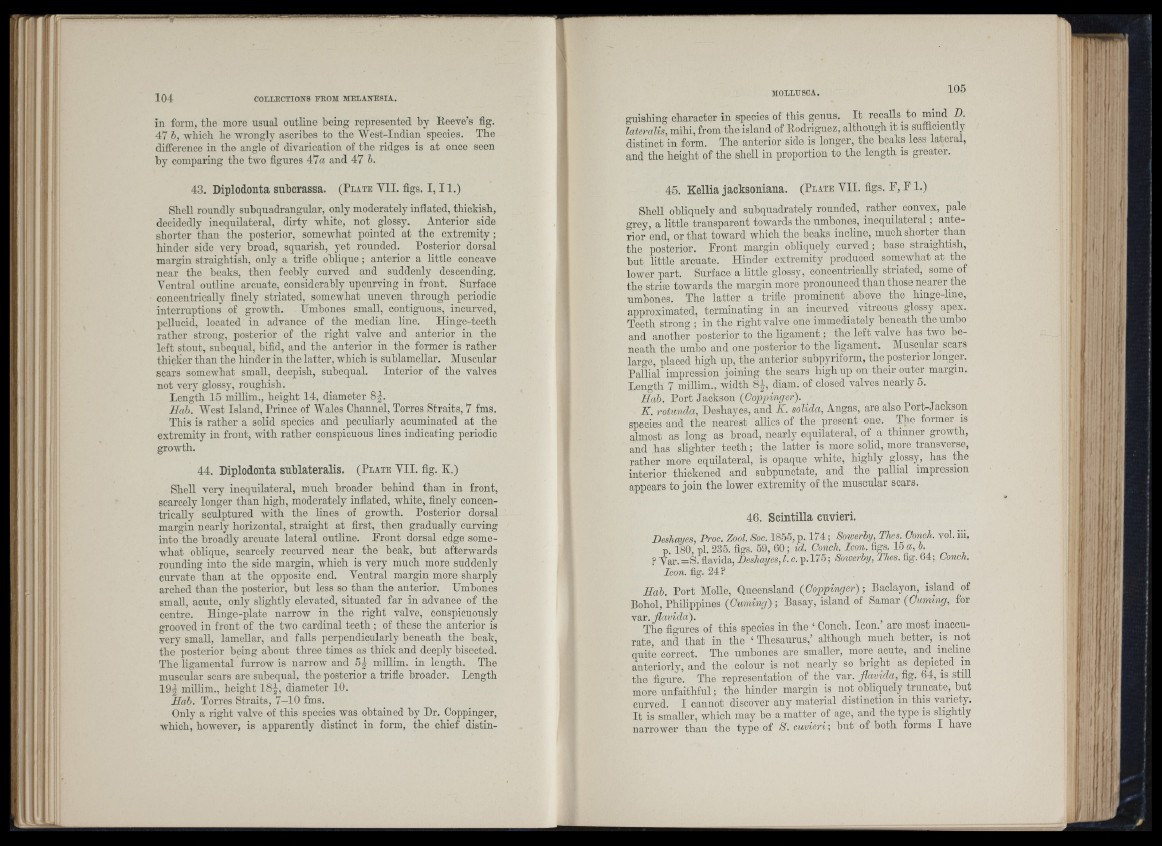
in form, the more usual outline being represented by Reeve’s fig.
47 b, which he wrongly ascribes to the West-Indian species. The
difference in the angle of divarication of the ridges is at once seen
by comparing the two figures 47« and 47 h.
43. Diplodonta subcrassa. (P la te VII. figs. 1 , 1 1.)
Shell roundly subquadrangular, only moderately infiatcd, thickish,
decidedly inequilateral, dirty white, not glossy. Anterior side
shorter than the posterior, somewhat pointed at the extremity ;
hinder side very broad, squarish, yet rounded. Posterior dorsal
margin straightish, only a trifie oblique; anterior a little concave
near the beaks, then feebly curved and suddenly descending.
Ventral outline arcuate, considerably upcurving in front. Surface
concentrically finely striated, somewhat uneven through periodic
interruptions of growth. Umbones small, contiguous, incurved,
pellucid, located in advance of the median line. Hinge-tceth
rather strong, posterior of the right valve and anterior in the
left stout, subeqnal, bifid, and the anterior in the former is rather
thicker than the hinder in the latter, which is sublamellar. Muscular
scars somewhat small, deepish, subeqnal. Interior of the valves
not very glossy, roughish.
Length 15 millim., height 14, diameter 8 |.
Hab. West Island, Prince of Wales Channel, Torres Straits, 7 fms.
This is rather a solid species and peculiarly acuminated at the
extremity in front, with rather conspicuous lines indicating periodic
growth.
44. Diplodonta sublateralis. (P la te Y II. fig. K.)
Shell very inequilateral, much broader behind than in front,
scarcely longer than high, moderately inflated, white, finely concentrically
sculptured with the lines of growth. Posterior dorsal
margin nearly horizontal, straight at first, then gradually curving
into the broadly arcuate lateral outline. Pront dorsal edge somewhat
oblique, scarcely recurved near the beak, hut afterwards
rounding into the side margin, which is very much more suddenly
cnrvate than at the opposite end. Ventral margin more sharply
arched than the posterior, but less so than the anterior. Umbones
small, acute, only slightly elevated, situated far in advance of the
centre. Hinge-plate narrow in the right valve, conspicuously
grooved in front of the two cardinal teeth ; of these the anterior is
very small, lamellar, and falls perpendicularly beneath the beak,
the posterior being about three times as thick and deeply bisected.
The ligamental furrow is narrow and 5 | millim. in length. The
muscular scars are snhequal, the posterior a trifie broader. Length
1 9 | millim., height 1 8 |, diameter 10.
Hab. Torres Straits, 7-10 fms.
Only a right valve of this species was obtained by Dr. Coppinger,
which, however, is apparently distinct in form, the chief distinI
guishing character in species of this genus. I t recalls_ to mind D.
lateralis, mihi, from the island of Rodriguez, although it is sufficiently
distinct in form. The anterior side is longer, the beaks loss lateral,
and the height of the shell in proportion to the length is greater.
45. Kellia jacksoniana. ( P l a t e Y II. figs. F, F 1.)
SheU. obliquely and suhqiiadrately rounded, rather convex, pale
grey, a little transparent towards the umbones, inequilateral ; anterior
end, or th at toward which the beaks incline, much shorter than
the posterior. Front margin obliquely curved ; base straightish,
but little arcuate. Hinder extremity produced somewhat at the
loAver part. Surface a little glossy, concentrically striated, some of
the striæ towards the margin more pronounced than those nearer the
umbones. The latter a trifie prominent above the hinge-lme,
approximated, terminating in an incurved vitreous glossy apex.
Teeth strong ; in the right valve one immediately beneath the umbo
and another posterior to the ligament ; the left valve has tAvo beneath
the umbo and one posterior to the ligament. Muscular scars
large, placed high up, the anterior subpyriform, the posterior longer.
Pallial impression joining the scars high up on their outor margin.
Length 7 millim., Avidth 84, diam. of closed valves nearly 5.
Hah. Port Jackson {Coppinger). -r, t i
K. rotunda, Deshayes, and K. solida, Angas, are also I ort-Jackson
species and the nearest allies of the present one. The former is
almost as long as broad, nearly equilateral, of a thinner growth,
and has slighter teeth ; the latter is more solid, more transverse,
rather more equilateral, is opaque white, highly glossy, has the
interior thickened and suhpunctate, and the pallial impression
ajipears to join the lower extremity of the muscular scars.
46. Scintilla cnvicri.
Deshayes, Proc. Zool. Soc. 1855, p. 174 ; Sotverby, Thes. Conch, vol. iii.
p. 180, pi. 235. figs. 59, 60 ; id. Conch Icon figs 15 «, b
? Var. =S. flavida, Deshayes, I. c. p. 17o ; Soiuerby, Thes. fig. 64; Conch.
Icon. fig. 24 ?
Hah. Port Molle, Queensland {Coppinger); Baclayon, island of
Bohol, Philippines (Uitmmp) ; Basay, island of Samar (U itm ^ , for
var. flavida). , .
The figures of this species in the ‘ Conch. Icon, are most inaccurate,
and that in the ‘ Thesaurus,’ although much better, is not
Quite correct. The umbones are smaller, more acute, and_ incline
anteriorly, and the colour is not nearly so bright as depicted in
the fio’ure. The representation of the var. flavida, fig. 64, is still
more unfaithful; the hinder margin is not obliquely triincate,_hut
curved. I cannot discover any material distinction in this variety.
I t is smaller, which majf be a matter of age, and the typo is slightly
narrower than tho type of S. cuvieri ; but of both forms I have
III
i '
I
I
il : ;
ij ^ I
j ■
I !
i; I
f( *I
li f
I • ;
I I'M
I !i I